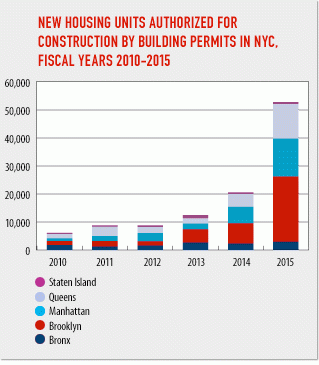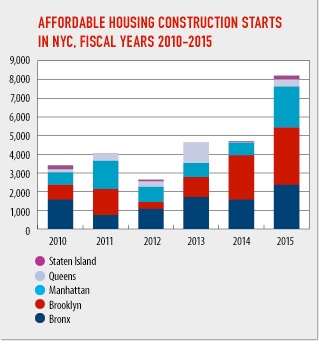
New york city residential permits skyrocketed in fiscal year 2015; brooklyn easily leads the pack
Hot Housing Market and Pending Regulatory Changes Spark Remarkable Surge in First Half of the Year
The New York City Department of Buildings (DOB) authorized construction of 52,618 residential units in Fiscal Year (FY) 2015 (July 1, 2014 - June 30, 2015), a 156 percent increase from FY 2014, when permits were issued for 20,574 units, according to a New York Building Congress analysis of U.S. Census data.
This marks the sixth consecutive year of increases in permitted units. Since a post-recession low of 6,194 authorized units in FY 2010, the DOB issued permits for 8,781 units in FY 2011, 8,800 units in FY 2012, and 12,939 units in FY 2013.
Borough Breakdown
While the number of permits rose in each of the five boroughs, Brooklyn experienced the most dramatic increase with 23,326 dwelling units authorized for construction in FY 2015, compared to 7,181 in FY 2014.
“The Building Congress has long believed that New York City needs to produce at least 20,000 new housing units each year to keep pace with demand and a growing population,” said New York Building Congress President Richard T. Anderson. “But we never thought we would see a year in which that many units would be authorized in one borough alone. The current strength of the Brooklyn market is quite remarkable.”
Manhattan, with 13,499 permitted units, was second to Brooklyn for the third consecutive fiscal year. Queens was home to 12,326 newly-authorized units, followed by the Bronx with 2,753, and Staten Island with 714.
Affordable Also Rises
According to a parallel Building Congress analysis of New York City Department of Housing Preservation and Development (HPD) data, construction started on 8,483 units of affordable housing in FY 2015, an 80 percent increase from 4,708 reached in FY 2013.
It is worth noting that while the raw number of affordable units rose significantly, that number fell as a percentage of overall units authorized in the five boroughs. In FY 2015, the number of affordable units started equaled about 16 percent of the housing units authorized, compared with 23 percent in FY 2014. In 2010 when the housing market was still reeling from the recession, affordable housing starts equaled 55 percent of all authorized units.
“Mayor de Blasio has declared that he will create 80,000 new units of affordable housing over the next decade, and he’s off to a strong start,” added Mr. Anderson. “In order to sustain and build upon it, his administration, with the help of Albany, will need to find a way to entice developers to include an even greater percentage of affordable units in their market-driven development projects.”
Echoes of 2008
Of the 52,618 permits issued by the DOB in FY 2015, 42,088 were issued from the start of January through June of this year. The surge can be attributed, in part, to the strength of the residential sector. It also can be traced, however, to the looming June 15 expiration of New York State’s 421-a tax abatement program – and the recognition that even if the program were reauthorized, it would be in a form that was considerably less advantageous to developers of new housing.
A similar situation occurred in the spring of 2008. After the adoption of a new, less generous, and more restrictive version of the 421-a program that would apply to any residential project started after July 1 of that year, a number of developers rushed to obtain the necessary permits and start foundations. As a result, the DOB issued permits for 26,851 residential units in the first half of the year – with more than 17,000 issued in June of that year alone.
“Residential construction spending was already at record levels, even prior to this recent surge, and barring an unforeseen economic downturn, we have every reason to believe the pace will continue and maybe even accelerate in the coming years,” said Mr. Anderson. “That said, we think it’s safe to predict that the number of new residential permits will cool considerably for the remainder of the year – and for at least as long as uncertainty remains over the future of the 421-a program.”Charts and Diagrams

Source: U.S. Bureau of the Census

Source: NYC Department of Housing Preservation and Development



